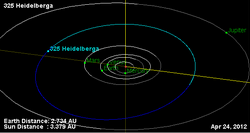Astronomy:325 Heidelberga
From HandWiki
Short description: Main-belt asteroid
 Orbital diagram | |
| Discovery | |
|---|---|
| Discovered by | Max Wolf |
| Discovery date | 4 March 1892 |
| Designations | |
| (325) Heidelberga | |
| Pronunciation | /ˌhaɪdəlˈbɜːrɡə/ |
| Named after | Heidelberg |
| Minor planet category | Main belt |
| Adjectives | Heidelergian /ˌhaɪdəlˈbɜːrdʒiən, -ɡiən/ |
| Orbital characteristics[1] | |
| Epoch 31 July 2016 (JD 2457600.5) | |
| Uncertainty parameter 0 | |
| Observation arc | 117.86 yr (43050 d) |
| |{{{apsis}}}|helion}} | 3.7223 astronomical unit|AU (556.85 Gm) |
| |{{{apsis}}}|helion}} | 2.69998 AU (403.911 Gm) |
| 3.21115 AU (480.381 Gm) | |
| Eccentricity | 0.15919 |
| Orbital period | 5.75 yr (2101.8 d) |
| Mean anomaly | 7.2090° |
| Mean motion | 0° 10m 16.608s / day |
| Inclination | 8.5545° |
| Longitude of ascending node | 344.881° |
| 68.563° | |
| Physical characteristics | |
| Dimensions | 75.72±1.7 km |
| Rotation period | 6.737 h (0.2807 d) |
| Geometric albedo | 0.1068±0.005 |
| Absolute magnitude (H) | 8.65 |
Heidelberga (minor planet designation: 325 Heidelberga) is a large main belt asteroid that was discovered by German astronomer Max Wolf on 4 March 1892 in Heidelberg. It is orbiting the Sun at a distance of 3.21 astronomical unit|AU with an eccentricity (oval shape) of 0.159. The orbital plane is inclined at an angle of 8.55° to the ecliptic.[1]
Based upon its spectrum, 325 Heidelberga is classified as an M-type asteroid. No absorption features have been detected with certainty, indicating it most likely has a nickel-iron or enstatite chondrite composition.[2] A weak feature in the near infrared spectrum indicates the presence of low-iron orthopyroxene on the asteroid surface.[3]
References
- ↑ 1.0 1.1 Yeomans, Donald K., "325 Heidelberga", JPL Small-Body Database Browser (NASA Jet Propulsion Laboratory), https://ssd.jpl.nasa.gov/sbdb.cgi?sstr=325, retrieved 11 May 2016.
- ↑ Hardersen, Paul S.; Gaffey, Michael J.; Abell, Paul A. (January 1983), "Near-IR spectral evidence for the presence of iron-poor orthopyroxenes on the surfaces of six M-type asteroids", Icarus 175 (1): pp. 141–158, doi:10.1016/j.icarus.2004.10.017, Bibcode: 2005Icar..175..141H.
- ↑ Takir, D.; Hardersen, P. S.; Gaffey, M. J. (March 2008), "The Near-Infrared Spectroscopy of Two M-Class Main Belt Asteroids, 77 Frigga and 325 Heidelberga", 39th Lunar and Planetary Science Conference, (Lunar and Planetary Science XXXIX), held March 10–14, 2008 in League City, Texas. LPI Contribution No. 1391: p. 1084, Bibcode: 2008LPI....39.1084T
External links
- 325 Heidelberga at AstDyS-2, Asteroids—Dynamic Site
- 325 Heidelberga at the JPL Small-Body Database
 |

